http://www.mockingthedraft.com/2011...n-of-heisman-trophy-winner-robert-griffin-iii
Baylor Quarterback Robert Griffin III was just named the 2011 Heisman Trophy winner. So while he's talk of the town, I thought I would re-post my film breakdown of him from way back in October (originally posted on Hogs Haven, then on Our Baylor Bears).
The games I based this breakdown on were the Texas A&M and TCU games earlier this season. But before we get to the film, what is it that we look for in a quarterback?
There are measurable's (agility, athleticism, durability, height, mobility, speed, strength and weight), intangibles (character, competitiveness, intelligence, leadership, toughness and work ethic) and football abilities (accuracy, arm strength, checking progressions, consistency, decision making, footwork, mechanics, pocket awareness, poise, reading coverage). Basically a long list of things we use to evaluate a quarterback, you get the idea.
So lets start with the measurable's. Griffin is listed as 6'2", 220 pounds, maybe an inch or so smaller than would be ideal but its about the right weight.
CBS Sports attributes him with a 4.52 second 40 yard dash. In comparison only
Tyrod Taylor, who ran a 4.51, ran faster among quarterbacks at the combine last year. While the 4th overall pick of the draft, wide receiver
A.J. Green, was only a shade faster. His athleticism saw him successful on the running track as well. From [ame="http://en.wikipedia.org/wiki/Robert_Griffin_III"]
Wikipedia[/ame]:
In track, he broke state records for the 110-meter hurdles. He ran the 110-meter hurdles in 13.55 seconds, and the 300-meter hurdles in 35.33 seconds. The 300-hurdles time was one-hundredth of a second short of breaking the national high school record. He was also a gold medalist in the 110 and 400-meter hurdles on the AAU track and the field circuit. He sprinted 13.46 in the 110-meter hurdles and 49.56 in the 400-meter hurdles as a junior in high school. In 2007, as a junior, he was rated the No. 1 high school 400-meter immediate hurdler in the country, and was tied at No. 1 for the 110-meter sprint hurdler in the nation. Also as a junior, he received the Gatorade Texas Boys Track and Field Athlete of the Year award.
The guy is more athletic than you could ask a quarterback to be. However, he has had injury troubles in the past, leading to durability questions. Griffin played less than a half of football in the 2009 season after suffering an ACL tear. He only played 25% of the 2010 season due to injuries that forced him to redshirt the year. This has lead to durability concerns, but he hasn't missed a game so far this season.
Then we have his intangibles, is he the kind of guy you want to be the leader in the locker room? Griffin is the son of two retired U.S. Army Sergeants. By all accounts, this has seen him brought up with a great work ethic and leadership ability. From interviews I've seen, he comes across as a genuine team player and good character guy. Quotes like these are music to NFL scouts and GM's ears:
"The biggest thing is trusting the guys around me," Griffin said. "I trust my offensive line, I trust the receivers that when the ball is in the air, they are going to be the ones who are catching it. They are going a great job of making plays all year." "As long as you go into the game with confidence in the people around you and the play-making ability of everybody else, it makes you a better player"
The rest of that story can be read
here, it's a pretty good read. He puts his trust into his teammates, and they give him trust and respect back. Just as a side note he's majoring in political science, so he's not exactly a dumb jock either. There's not many arguments that can be made against Robert Griffin's intangibles, he ticks all of these boxes.
So, we've established he's very athletic for a quarterback and that he's everything you want as a leader in the locker room. But all of that is useless unless he can translate it to success on the football field. From the tape I've watched, he has no trouble doing so.
Accuracy:
Robert Griffin is currently averaging 78% completion rate for the season. But in college, that could be boosted by dink and dunk type offenses. So here's a few examples to prove he's a very accurate passer over different distances.

The receiver is running an eight yard in pattern. Griffin has to make sure he avoids the linebacker in the middle of the field but cant afford to overthrow it or the defender covering the receiver has a chance to make the play.
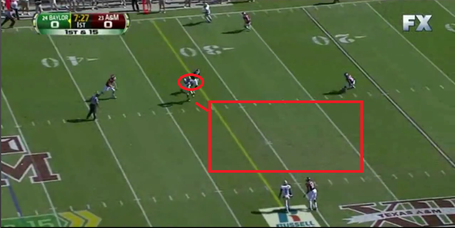
He not only avoids the defenders, but he hits the receiver perfectly in-stride and that allows him to run on for the first down in the huge open area.
But that's a throw you would expect a quarterback to make. This one is a much tighter throw. It does fall incomplete, but as you'll see that has nothing to do with Griffin.
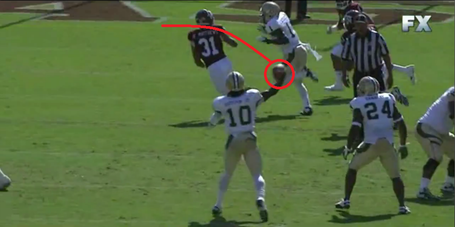
Griffin is trying to fit this one in a tight space to his top receiver
Kendall Wright on the crossing pattern.
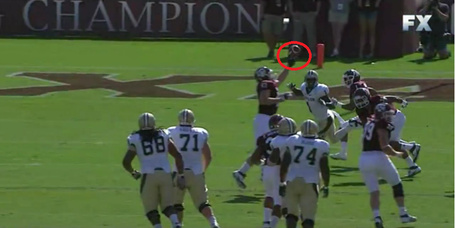
The ball placement is superb, just over the out-stretched arm of the A&M defender (shades of the
Aaron Rodgers touchdown throw over
Troy Polamalu in the Super Bowl).

He hits Wright in-stride and exactly where the receiver would want the ball, Wright just drops it.
Or how about this throw in the red zone.
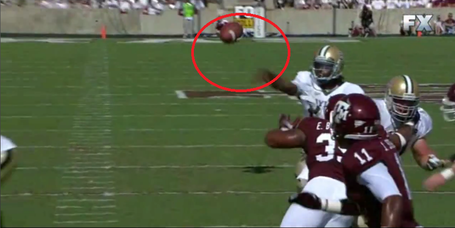
Wright ran a slant on this play, and comes back to get the ball.
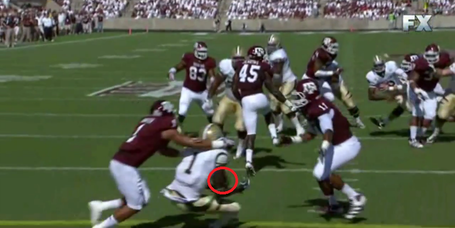
Griffin throws it low so that Wright is the only person who can make a play on the ball. He does that and gets a touchdown.
One final display of his accuracy, on deep pattern up the sideline.
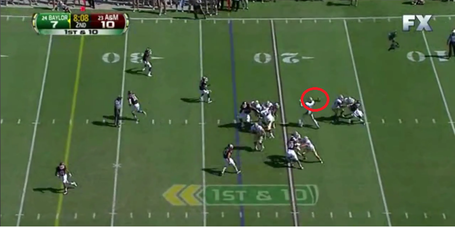
Griffin releases the deep ball to the top sideline. You can see the receiver yet because he is behind the scoreboard in the top corner. Take note, Griffin is on his own 18/19 yard line when the ball is thrown.
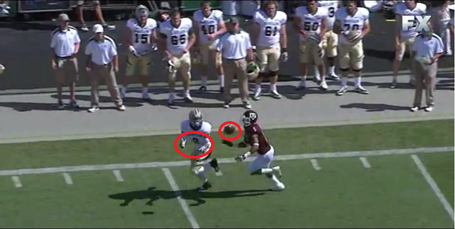
Again he manages to hit the receiver in-stride, and right into his hands where only he can make the play on the ball.
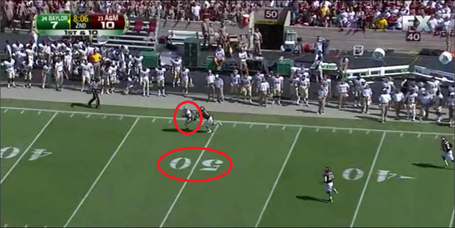
When the catch is made, the receiver is on the other side of the 50 yard line. Thats incredible accuracy over a 30+ yard pass. The receiver breaks a tackle and scores a touchdown.
Arm Strength:
Well if the last 30 yard throw wasn't enough to show off his arm strength, how about a couple of 50 yard throws?
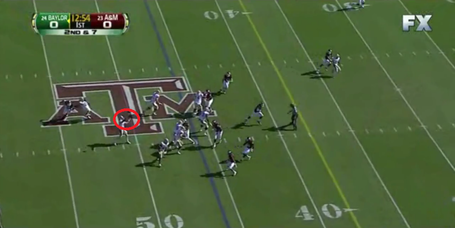
Griffin has Wright on a deep vertical or a go route. Notice he's just behind the 50 yard line.
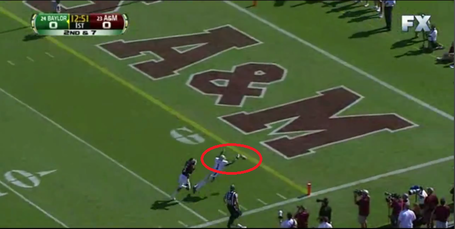
Griffin just overthrows the diving Wright. It's almost impressive that you can overthrow a receiver on a 50 yard pass.
Just in case you think these are fluke throws, I'll show you one more.
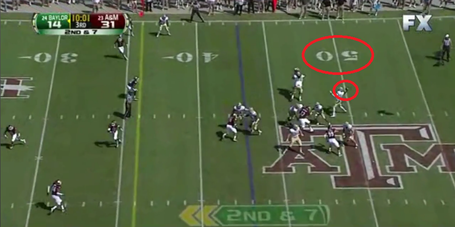
Another deep pattern, and again Griffin is on roughly the 50.
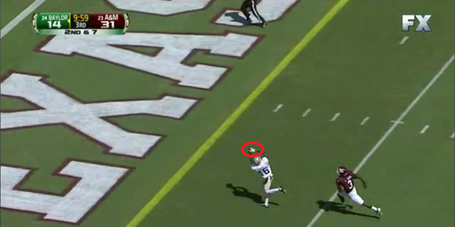
He not only hits his receiver this time, but puts it perfectly in his stride so that the receiver doesn't have to make any adjustments and pretty much guarantees the touchdown.
Still not satisfied, how about this 40 yarder against TCU.
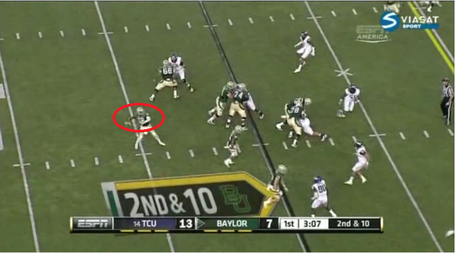
Griffin winds up from the 40.

And almost effortlessly hits Wright perfectly for a big touchdown. Showing off not only his arm strength, but his deep ball accuracy as well. A lot of people believe his deep accuracy is his best quality.
Checking Progressions:
Admittedly, this isn't something he's asked to do all that often or if he is, the primary read gets open a lot! But still, he can do it, have a look.
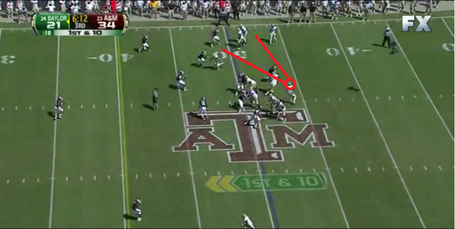
On his initial drop back, he checks the short quick option.
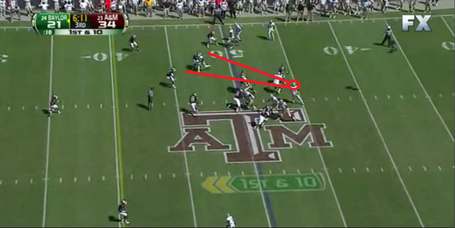
He moves on to the slant route and realises it's covered.
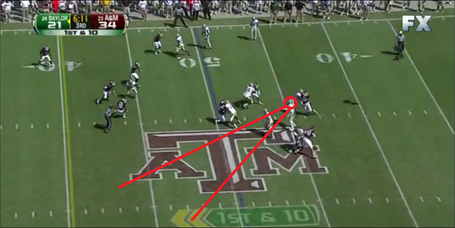
He checks his final option and once he see's its open, he pulls the trigger.
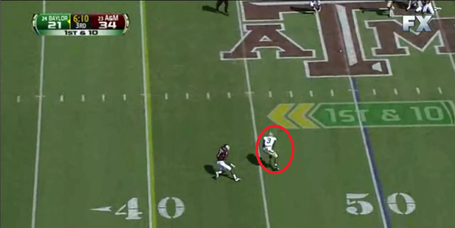
He hits the receiver and gives him the chance to make a play, which he does by breaking a tackle and getting a first down.
Here's another example from the TCU game.
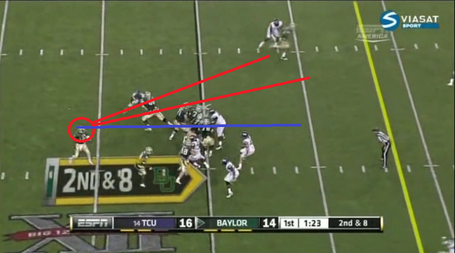
The blue line shows how he keeps his helmet aiming straight down-field to keep the safeties from reading him. Meanwhile he uses his eyes to check the first route at the top of the picture before realising its covered.
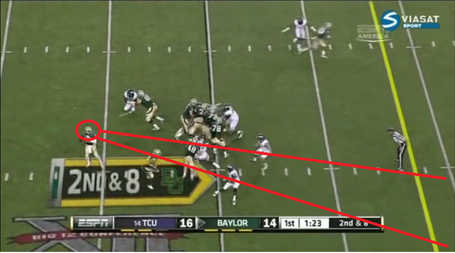
He moves onto his second read.
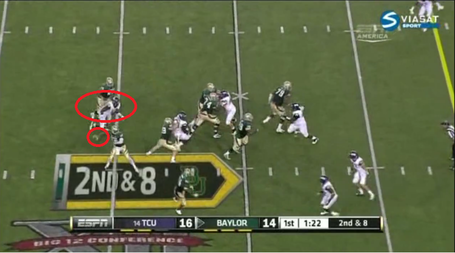
He see's that its open, and throws just in time as the TCU defender is closing down on him.
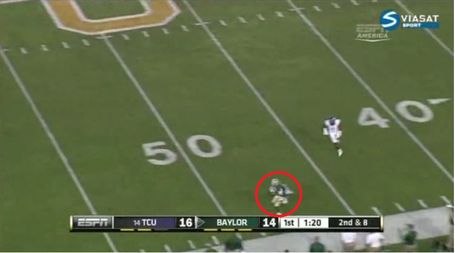
Griffin completes the pass for a first down and a big gain.
Mechanics and Footwork:
This is where some critics come in. Some people believe he has a tendency to have a bit of a wind-up before he throws, lengthening the release. I don't see this myself, on the contrary, he appears to have a very quick release in my opinion. Have a look at this play-action pass to the tight end.
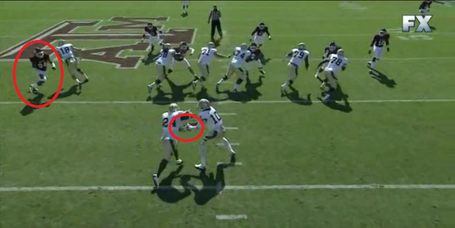
The thing to look at in these pictures to determine the speed of the release is the defender circled in red. Griffin has to fake the hand-off and get the ball up from his waste to his release point.
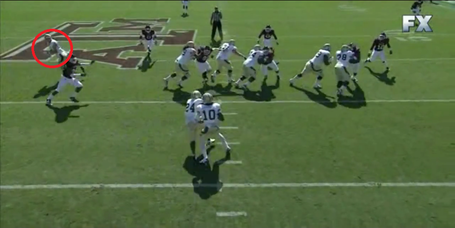
The tight end is circled in red to show his target.
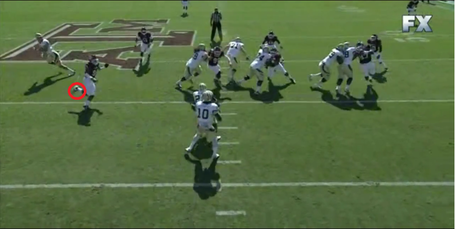
Now Griffin just begins his throwing motion, watch the circled foot of the defender.
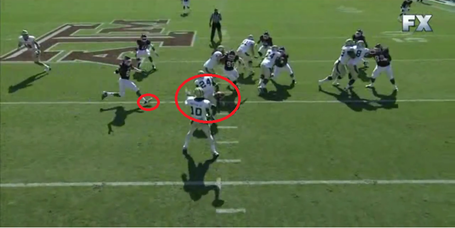
Griffin gets the ball from his chest to nearly the point of release before the defender lands that foot.
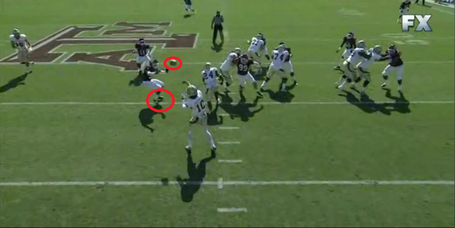
The ball is out (I couldn't get a shot between these two frames, sorry) before the defender gets his other foot down. Plenty quick enough for me.
In terms of his release point, I take you back to an earlier picture.
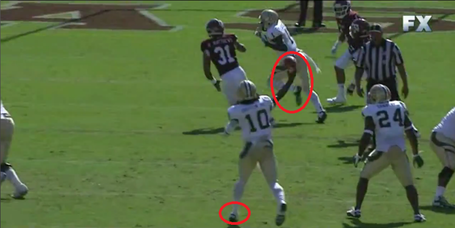
As you can see, he steps nicely into his throws, transferring his weight to get a nice zip on the ball. He's got a nice high release. It's not a completely over the top release that you might see from a
Peyton Manning or even an
Andrew Luck, but it works for him, and he doesn't get a lot of passes batted down at the line.
His footwork is probably one of his biggest weaknesses and its not that bad. He does get "dancing feet" in the pocket while waiting for receivers to get open, but its nothing that NFL coaching can't fix.
Mobility:
This is another one of Griffin's biggest strengths. His mobility allows him to extend plays, roll outside the pocket and make good throws on the run. There's so many examples to choose from, but I think this one shows it best.
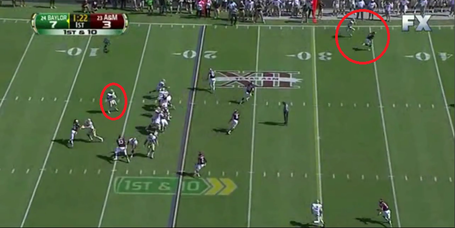
Initially Griffin looks to the top of the picture for the deep throw, but realises that its covered.
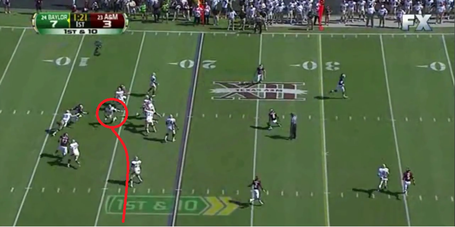
With pressure coming, Griffin decides to get out of the pocket.
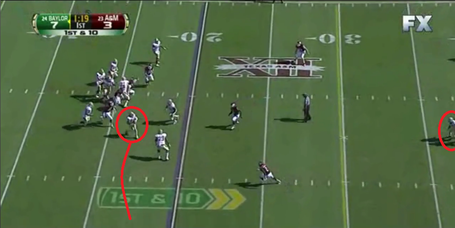
What Griffin does really well is keep his eyes down-field the whole time, still looking for a receiver.

Griffin only takes his eyes away from receivers when he has a defender charging him down. He tucks the ball and protects it with one hand, while stiff arming the defender with the other to avoid being tackled.
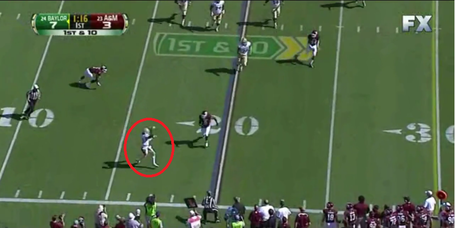
Griffin manages to get the throw off at an awkward angle.
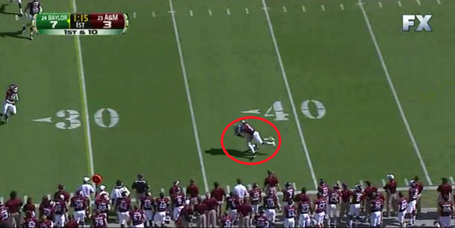
Not only managing to accurately hit the receiver, but put it in the only place that the defender can't get to. Baylor pick up the first down.
But these are just my views on Robert Griffin III. So I reached out to
Dan Kadar, SB nation college scout over at Mocking the Draft. He put up his piece on
Robert Griffin III over there, so go check that out. I asked him what he thought were some of his biggest strengths and weaknesses.
The biggest difference for Griffin this season has been the types of throws he's making. In the past, he was more of a short game thrower, which made him a product of the spread Baylor uses. This season he's making much more difficult throws. One of the things I think people don't notice about Griffin is how tough he is. For better or worse, he's not a quarterback who is going to slide when he takes off and runs.
The downside that remains is that he's still learning the play calling and how to go through his progressions. He's not asked in the Baylor offense to make many complex reads, so he's behind the curve in that area. He also has some lapses where he'll pull the ball down too quickly and run with the ball. It hasn't hurt him as much in college, but that sort of thing doesn't translate particularly well to the pros.
Thanks to Dan for taking the time out to respond.





































